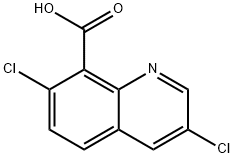3,7-디클로로-8-퀴놀린카복실산
|
|
3,7-디클로로-8-퀴놀린카복실산 속성
- 녹는점
- 274°C
- 끓는 점
- 405.4±40.0 °C(Predicted)
- 밀도
- 1.7500
- 굴절률
- 1.6100 (estimate)
- 인화점
- 100 °C
- 저장 조건
- Sealed in dry,Room Temperature
- 용해도
- DMSO(약간 용해됨), 메탄올(약간 용해됨)
- 물리적 상태
- Solid
- 산도 계수 (pKa)
- -3.26±0.10(Predicted)
- 색상
- 옅은 노랑
- BRN
- 7761858
- InChIKey
- FFSSWMQPCJRCRV-UHFFFAOYSA-N
안전
- 위험 및 안전 성명
- 위험 및 사전주의 사항 (GHS)
| 위험품 표기 | Xi | ||
|---|---|---|---|
| 위험 카페고리 넘버 | 43 | ||
| 안전지침서 | 2-24-37 | ||
| WGK 독일 | 2 | ||
| RTECS 번호 | VB1984000 | ||
| HS 번호 | 29334900 | ||
| 유해 물질 데이터 | 84087-01-4(Hazardous Substances Data) | ||
| 기존화학 물질 | 97-3-361 KE-10208 |
| 그림문자(GHS): |

|
||||||||||||||
|---|---|---|---|---|---|---|---|---|---|---|---|---|---|---|---|
| 신호 어: | Warning | ||||||||||||||
| 유해·위험 문구: |
|
||||||||||||||
| 예방조치문구: |
|
3,7-디클로로-8-퀴놀린카복실산 C화학적 특성, 용도, 생산
정의
ChEBI: A quinolinemonocarboxylic acid that is quinoline-8-carboxylic acid in which the hydrogens at positions 3 and 7 have been replaced by chlorines. It is used (particularly as its dimethylamine salt, known as quinclorac-dimethylammonium) as a (rather persisten ) herbicide for the post-emergence control of weeds in rice, grass and turf. It is not approved for use within the European Union.Pharmacology
The mechanism of action of quinclorac is controversial. Koo et al. (27) reported that quinclorac inhibited the incorporation of glucose into the cell wall of maize root cells. The synthesis of cellulose as well as some hemicellulose was inhibited at concentrations that inhibited whole plant growth, leading to the conclusion that quinclorac inhibits cell expansion by inhibiting glucose incorporation into the cell wall (27). These authors found that quinclorac inhibited root elongation in sensitive grasses at concentrations that inhibited cell wall biosynthesis. Cell wall biosynthesis in tolerant grasses was much less affected by quinclorac compared with sensitive grasses (28). Grossmann, on the other hand, believes that quinclorac acts as an auxinic herbicide in grasses as well as broadleaf plants, and that its herbicidal effects are due to production of cyanide (which is a byproduct of ethylene biosynthesis) and induction of the plant hormone abscisic acid (29). In this scenario, inhibition of cell wall biosynthesis would be considered a side effect, and not the primary cause of herbicidal injury. Differences in tolerance to quinclorac in this case are solely due to differences in ethylene induction, in that tolerant plants do not respond to quinclorac by synthesizing ethylene (29,30).신진 대사
Quinclorac has been under development by BASF since 1982, and it has been marketed since 1984, as the herbicide Facet. Synthesis data are not currently available. Absorption and uptake of quinclorac is rapid, with 85% uptake in crabgrass within the first 30 minutes. Although uptake of quinclorac is rapid, translocation is generally poor, especially in sensitive plants. Tolerant species, such as Kentucky bluegrass, tend to transport more of the chemical away from the area of uptake. This may, in part, explain how tolerant plants are less affected by quinclorac. Quinclorac is metabolized very slowly in both sensitive and tolerant grass species. In leafy spurge, themajor metabolite found 7 days after foliar application of quinclorac was a pentosylglucose ester.In susceptible grasses, early symptoms of quinclorac activity include rapid chlorosis starting at the elongation zone of newly expanding leaves. This is followed by more widespread chlorosis and, eventually, necrosis. On the other hand, quinclorac seems to affect susceptible broadleaf plants as an auxinic herbicide. Symptoms in broadleaf plants begin with induction of ethylene biosynthesis and epinastic bending of shoots and leaves. This is followed by growth inhibition, chlorosis, wilting, and, finally, necrosis.
3,7-디클로로-8-퀴놀린카복실산 준비 용품 및 원자재
원자재
니트로톨루엔
2-toluidine
3-Chloro-2-methylaniline
글리세린
염화제이철무수물
7-Dimethylamino-4-methylcoumarin
질산
규조토
2-methylnitrobenzene
준비 용품
3,7-디클로로-8-퀴놀린카복실산 공급 업체
글로벌( 324)공급 업체
| 공급자 | 전화 | 이메일 | 국가 | 제품 수 | 이점 |
|---|---|---|---|---|---|
| Hebei Chuanghai Biotechnology Co., Ltd | +8615531157085 |
abby@chuanghaibio.com | China | 8808 | 58 |
| Hebei Yanxi Chemical Co., Ltd. | +8617531153977 |
allison@yan-xi.com | China | 5854 | 58 |
| Qingdao Trust Agri Chemical Co.,Ltd | +8613573296305 |
aroma@qdtrustagri.com | China | 301 | 58 |
| Henan Fengda Chemical Co., Ltd | +86-371-86557731 +86-13613820652 |
info@fdachem.com | China | 20237 | 58 |
| Henan Tianfu Chemical Co.,Ltd. | +86-0371-55170693 +86-19937530512 |
info@tianfuchem.com | China | 21629 | 55 |
| career henan chemical co | +86-0371-86658258 +8613203830695 |
sales@coreychem.com | China | 29860 | 58 |
| Hubei Jusheng Technology Co.,Ltd. | 18871490254 |
linda@hubeijusheng.com | CHINA | 28172 | 58 |
| Xiamen AmoyChem Co., Ltd | +86-86-5926051114 +8615060885618 |
sales@amoychem.com | China | 6383 | 58 |
| Hubei xin bonus chemical co. LTD | 86-13657291602 |
linda@hubeijusheng.com | CHINA | 22963 | 58 |
| Chongqing Chemdad Co., Ltd | +86-023-6139-8061 +86-86-13650506873 |
sales@chemdad.com | China | 39894 | 58 |






